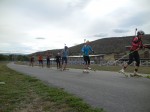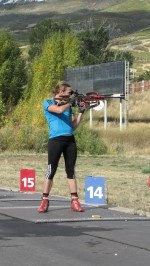
The U.S. biathlon community may be small, but one benefit of its size is that almost everyone can gather each year in October for a training camp at Soldier Hollow.
This year, the senior national team is joined in Utah by the junior national team as well as biathletes from the Maine Winter Sports Center, Durango and as far as Canada.
Inviting everyone brings training quality up, said national team women’s coach Jonne Kahkonen, who also supervises training for all resident national team athletes in Lake Placid. He was pleased by the work he had seen in Soldier Hollow so far.
“I’d say that in general, the summer has been good for the athletes training with the team, and for sure there are going to be a few athletes from outside the team who will be pushing hard as well,” Kahkonen told FasterSkier between training sessions on Monday. “So I’m sure that with all this competition within our nation it’s just going to bring the level up even more. And hopefully it’s good for the team members to remember that there are athletes outside the team, pushing.”
The group was taking advantage of Soldier Hollow’s shooting range and paved rollerski loops to concentrate on biathlon-specific training. There are few venues in North America as conducive to dryland training for biathlon, and with the race season fast approaching, locking down shooting procedures is especially important.

“For me, this time of year tends to be about putting together all the different pieces I’ve been working on rather than finding new focuses,” said national team member Susan Dunklee. “I have a couple positional and breathing concepts in shooting that I’ve been working on for the last month, and I’m trying to solidify these so they become automatic.
“One of the best things about training at the Soldier Hollow venue is having a full range with a rollerski loop. This camp is a good time for us to check in on our range approach and exit and make sure all are transitions are smooth and efficient.”
Kahkonen also said that the elevation of just over 5,000 feet was a training benefit – even though the World Cup only has one weekend of racing at any significant altitude this season.
“Personally, I enjoy coming to Utah, especially here in Midway, because it’s high enough that you get a little boost from that but it’s not too high that we’d have to compromise the intensity,” Kahkonen explained.
A major focus of the camp is to select athletes for another training camp, which will take place in Sweden before the opening World Cup races. “A” team members Tim Burke, Lowell Bailey, Leif Nordgren, Jay Hakkinen, Sara Studebaker, and Laura Spector are prequalified for the Sweden trip, but additional athletes will be selected based on two sprint time trials to be held today and Thursday.
The maximum team size for the Sweden camp is six men and six women, and from that group the team for the first period of World Cup races will be selected; the rest of the athletes would then be sent to the IBU Cup, a coordinated race series at a level just below the top.
“We can take up to six [women] and…. well, never say never, but that’s what it looks like right now, that we would end up doing that,” Kahkonen said.
Last year the team took five men but only two women (Studebaker and Spector) to the first period of European racing. Kahkonen said that the expanded women’s team for this year was made possible by a bigger budget and their success on the trails last winter.
“For sure one of the biggest things to make a change for this year is the level that they showed last year,” he said. “Both in the IBU Cup – they had some really good results there – and obviously on the World Cup as well.”
Dunklee, one of the athletes hoping to be added to the Sweden roster, said that the looming time trials had made her more cautious about the camp’s earlier workouts.
“For the last few days, I’ve been trying to be smart, take it easy, and adjust to the altitude,” she explained.
But that didn’t mean she wasn’t having fun. Like most of the athletes, Dunklee loves the scenery in Utah.
“My favorite things about being out here?” she asked. “Warm sunshine, brisk frosty mornings with snow on the peaks, hiking up canyons, juicy fresh peaches at the store, golden aspens and red oak leaves, and an amazing caterer that cooks for the team.”
While several members of the men’s team had brought their fly fishing gear out to Midway and spent several afternoons on the water, Dunklee had brought her shotgun and gone grouse hunting with Olympic veterans Tracy Colliander and Lanny Barnes.
“We’ve been twice, but haven’t got any yet,” she lamented.
And though the camp is designed for senior athletes, the juniors have been taking advantage of the larger community as well – albeit with their rifles, not shotguns or fishing rods.
Anna Kubek, a Minnesota high school student who recently qualified to represent the U.S. at the inaugural winter Youth Olympic Games, is one of the juniors who has been training at Soldier Hollow.
“Until now, we have had our own training schedule apart from the seniors,” Kubek said in an e-mail. “But the times we do see them train is amazing. It is great to see how they train and what it takes to be at their level. It’s really fun and a good experience to be around people close to my age.”
Kahkonen said that for better or for worse, it was difficult to have juniors and seniors training alongside one another.
“We have basically our own schedules because we don’t want to push the juniors too hard,” he explained. “The juniors are still in the developing phase and they need to do a little bit different kind of training, a little bit less hours and a little bit less intensity – a little bit less in general. But wherever we can it’s good to combine stuff and at least expose them to the training that the best athletes are doing.”
It’s symptomatic of the team’s more general approach for trying to develop athletes. Kahkonen believed that exposing the younger biathletes to the senior team’s workouts would help them improve even if they weren’t actually participating.
“It’s good for an athlete to see better athletes, and to see the best athletes in the country and even in the world,” he said. “That’s one of the reasons we do a training camp in Europe for the best athletes, just to expose them to the training that the other nations are doing.”
Next year, the team is hoping that the camp might be even more inclusive. While the group overlapped with a U.S. Ski Team camp at Soldier Hollow, they were unable to coordinate training because the biathletes were focused on using the range. In the future, however, that might change.
“We met with Chris Grover so we are already planning for next year so we can do even more, maybe even camps and not just single workouts together,” Kahkonen said. “We want to be ahead in the game and be planning already.”
The coach indicated that small collaborations between the two teams had gone well so far, and there was no reason not to strengthen the connection.
“This year we only really had one chance to match the workouts, which was in Lake Placid, when we had Climb to the Castle and training around that, so we ended up doing three intensity sessions together with the ski team,” he said.
“It seemed like both the skiers and the biathletes really liked doing something different, and so that’s definitely something we want to push for next year.”
(Photos in gallery below by Jonne Kahkonen)














